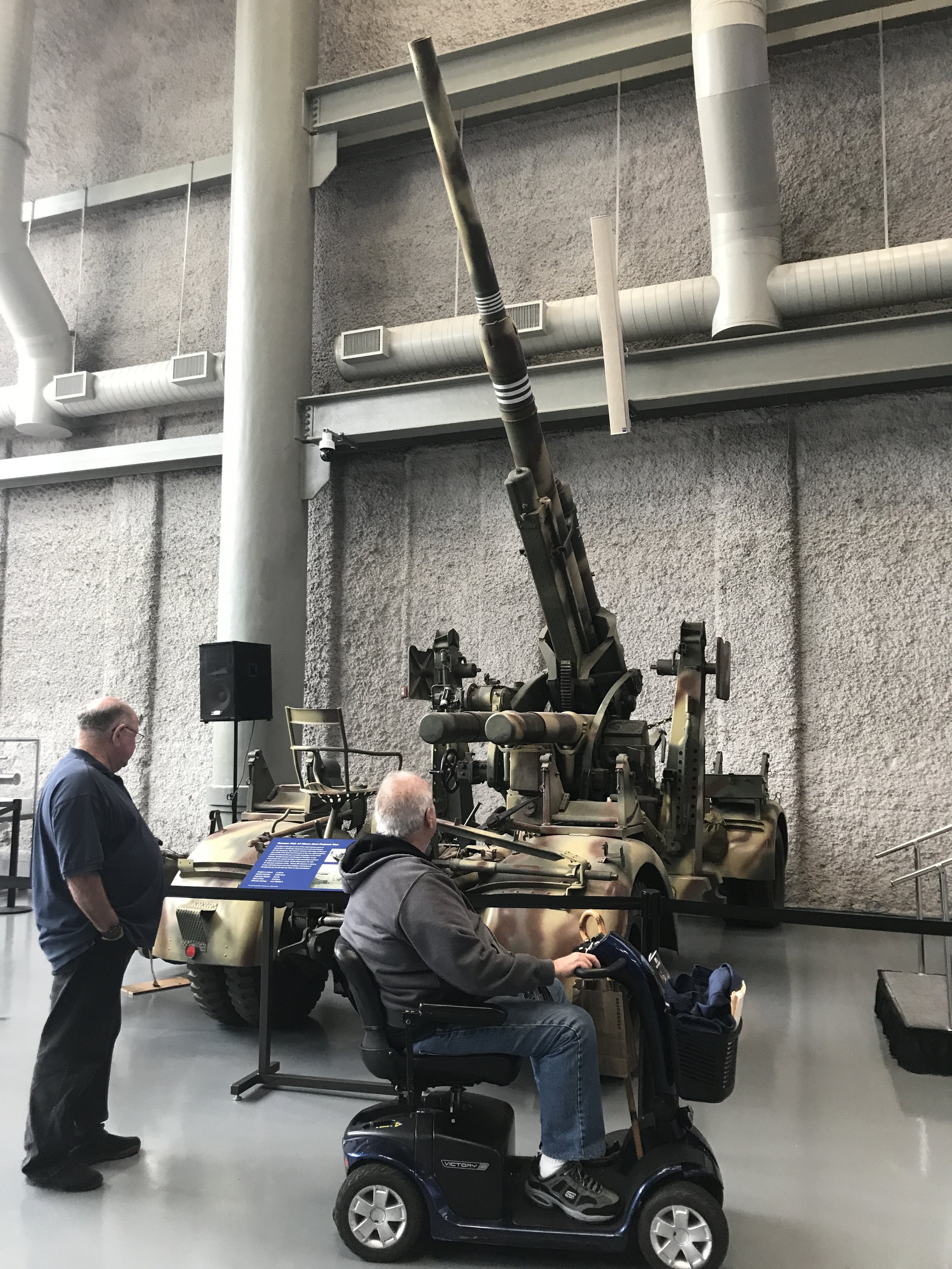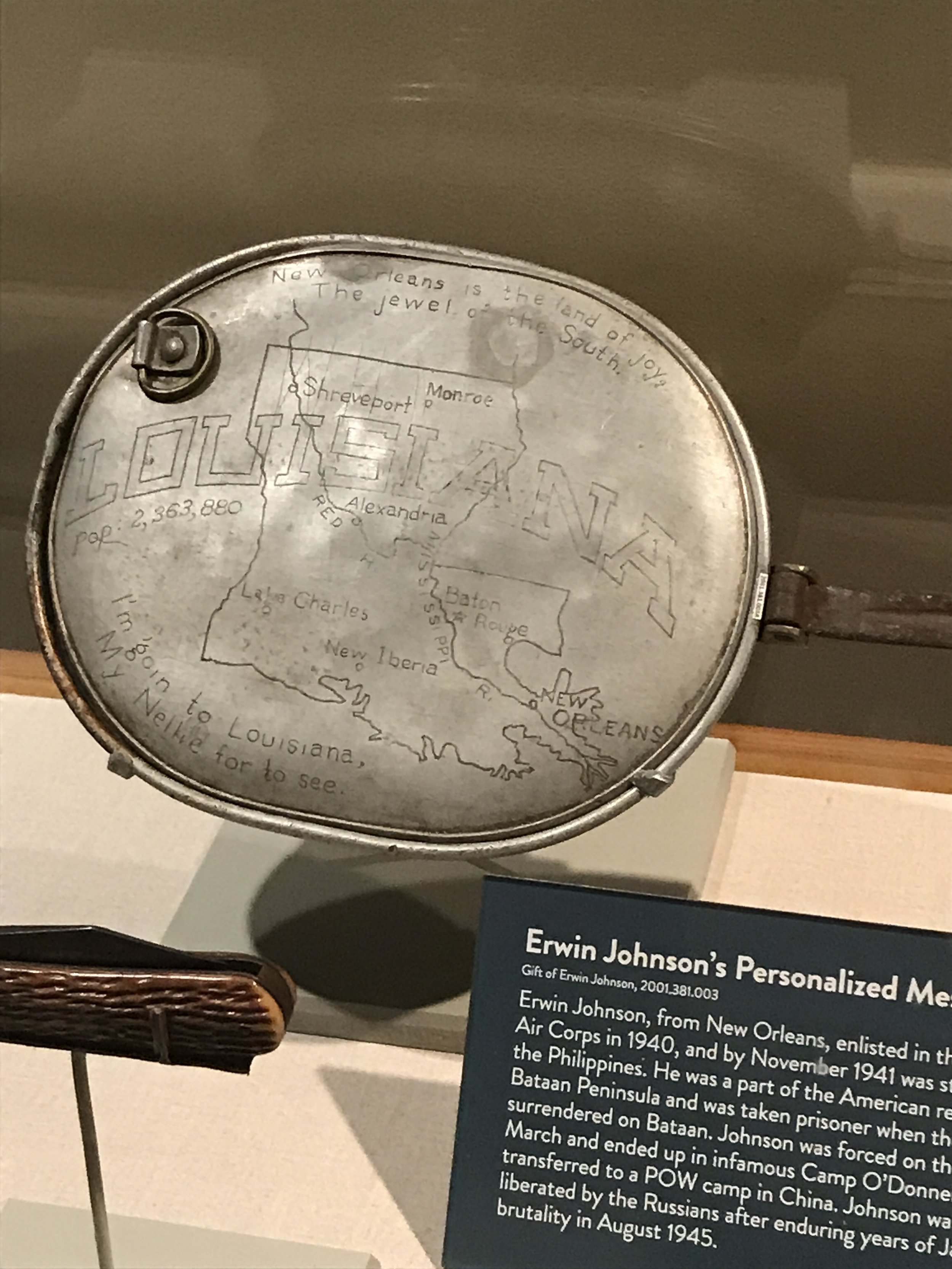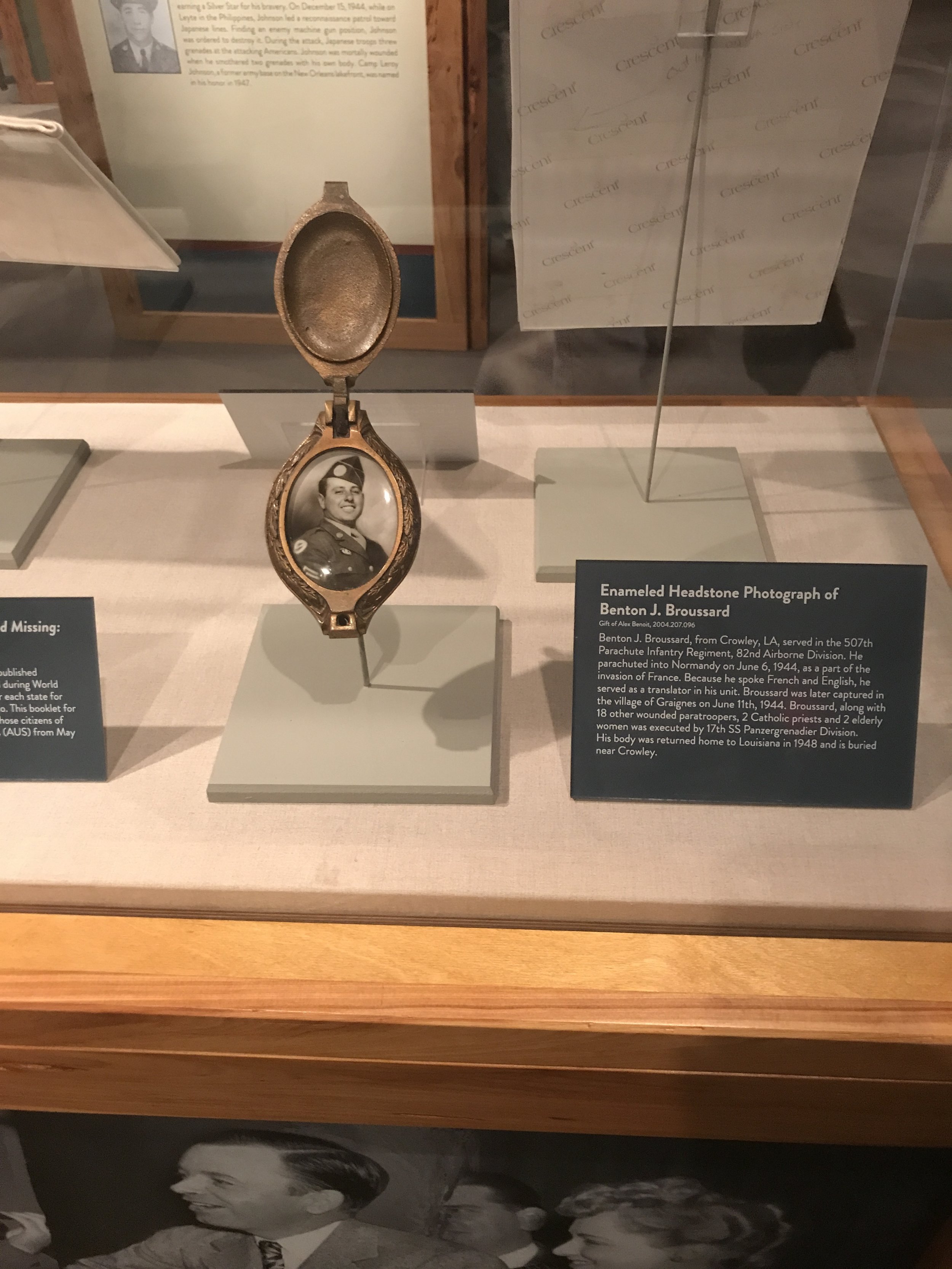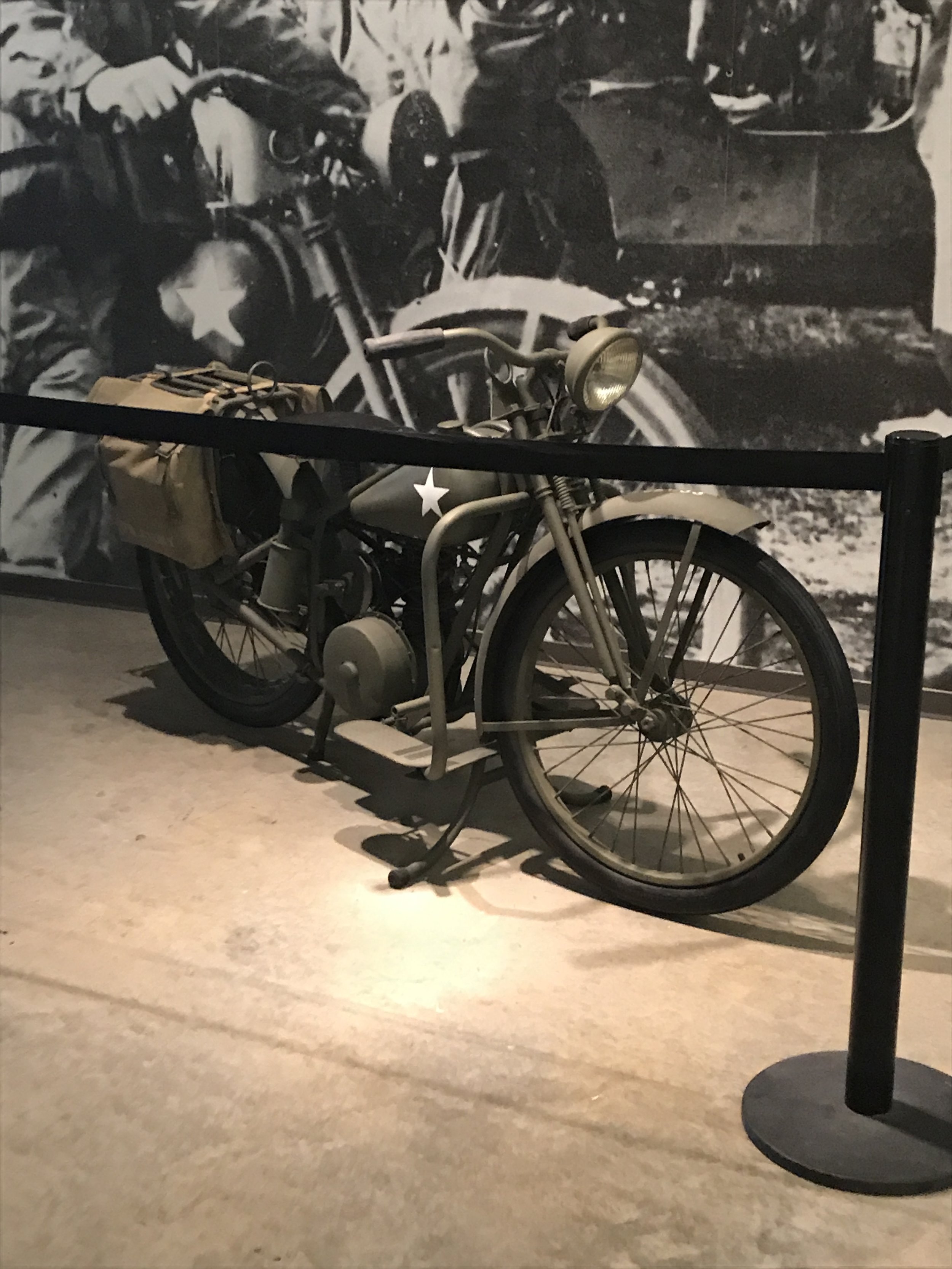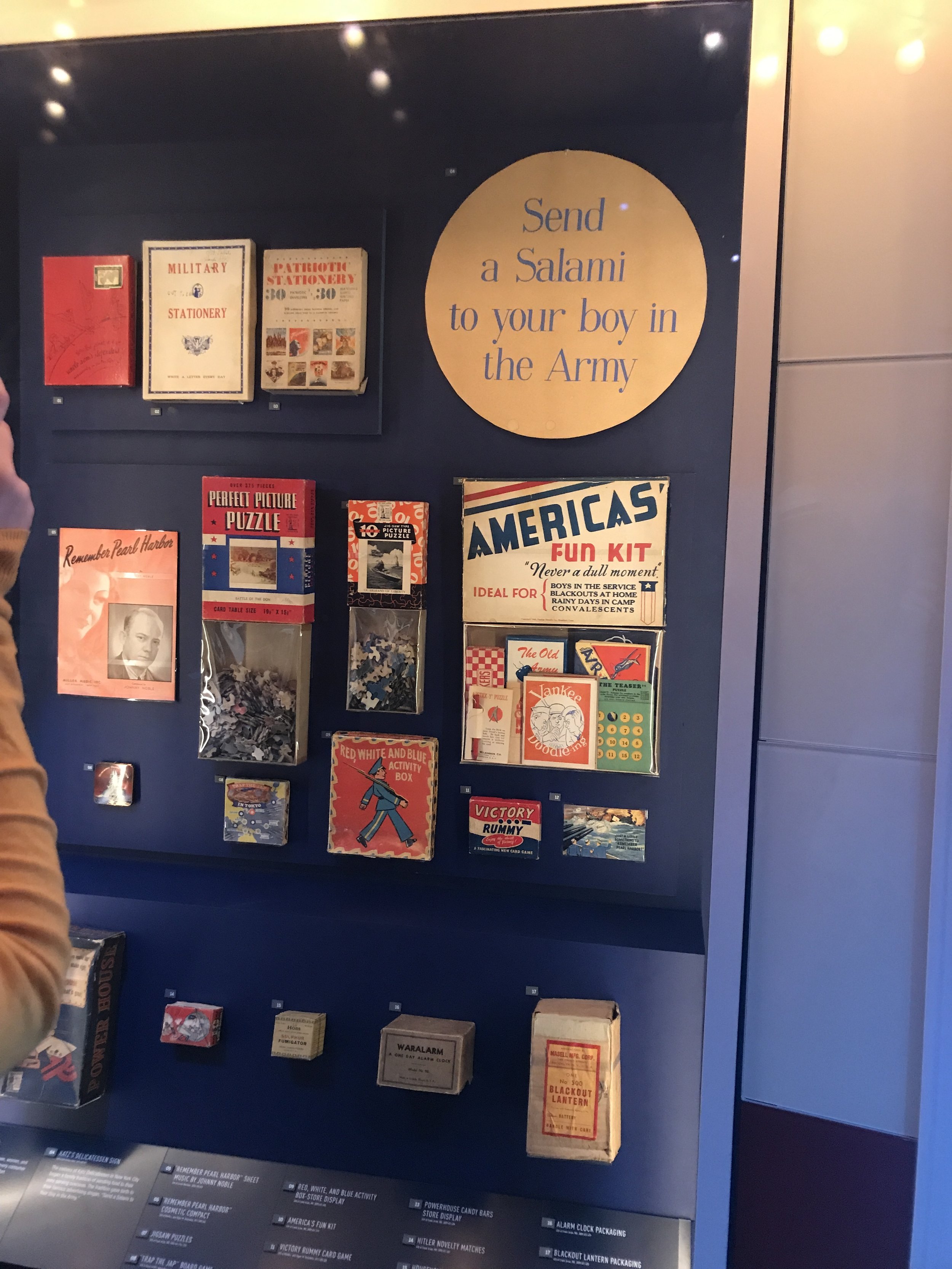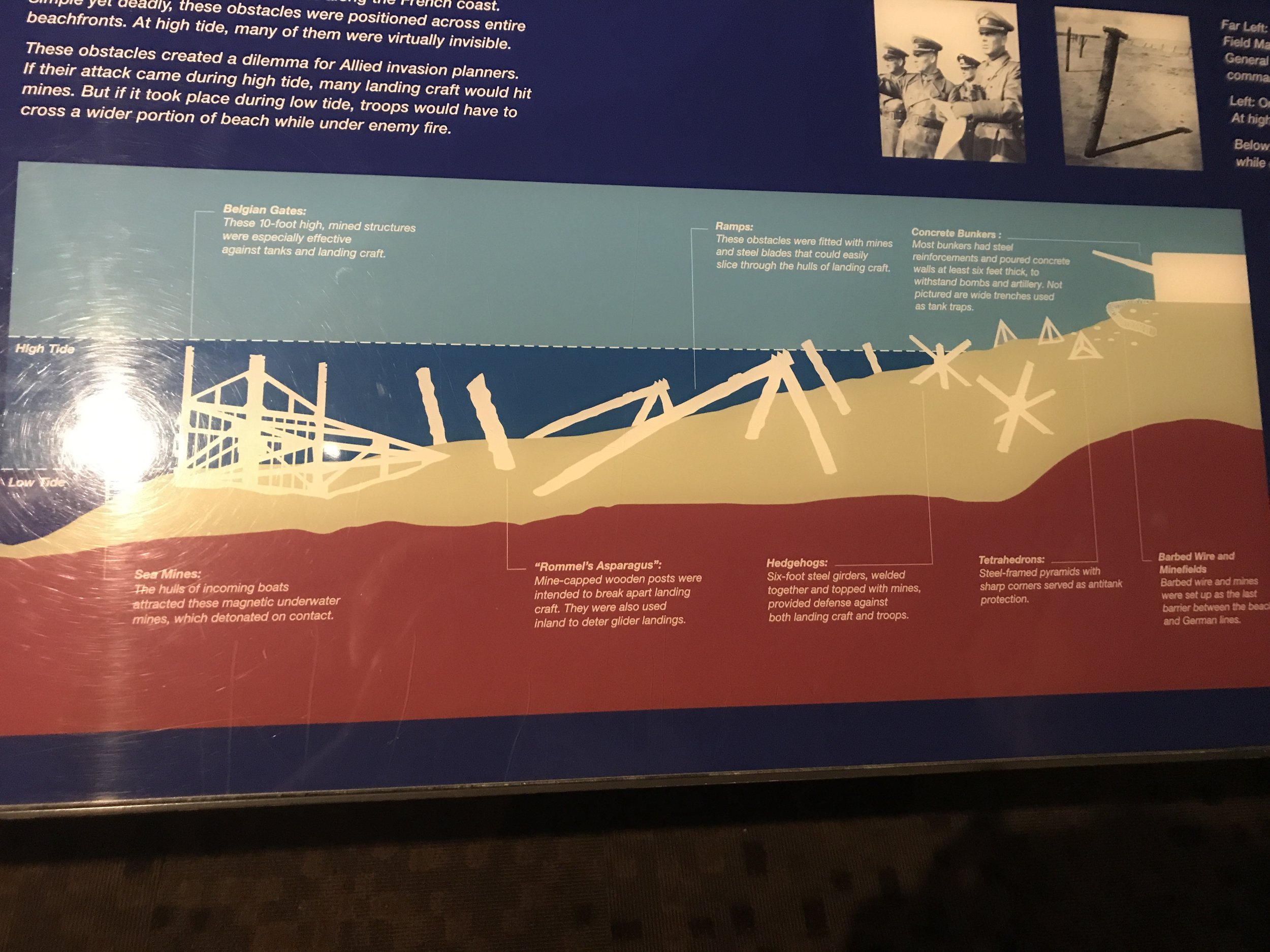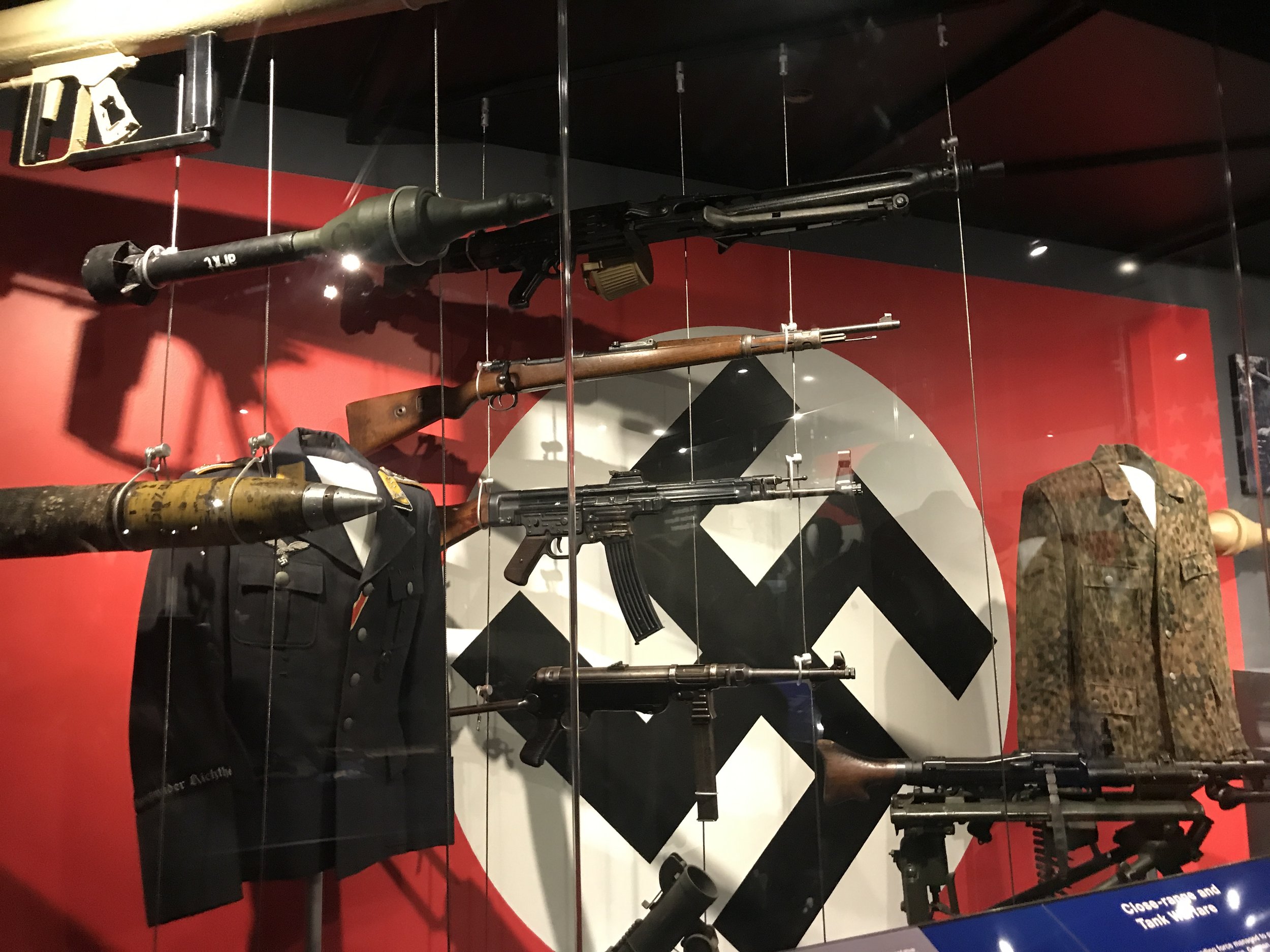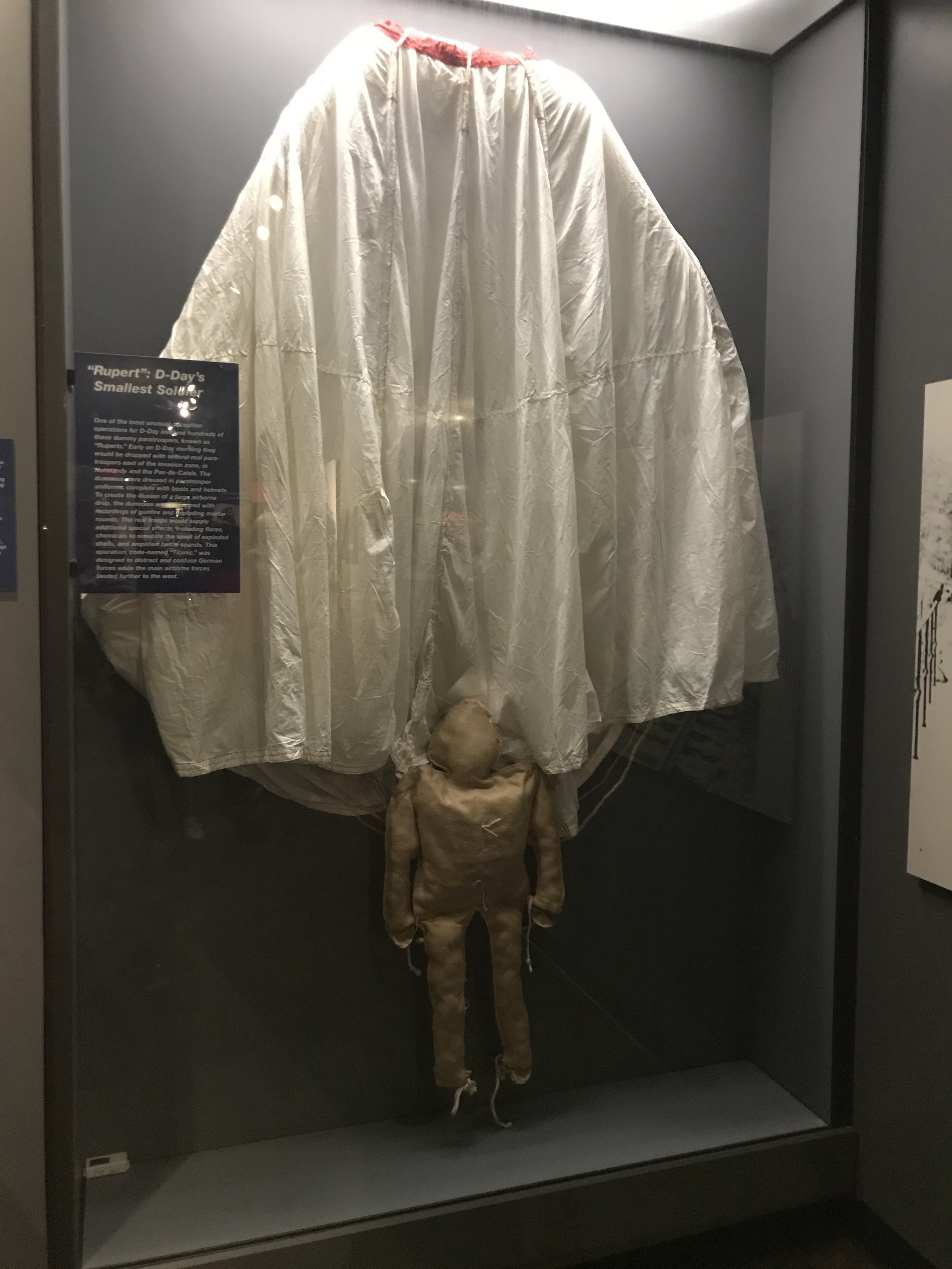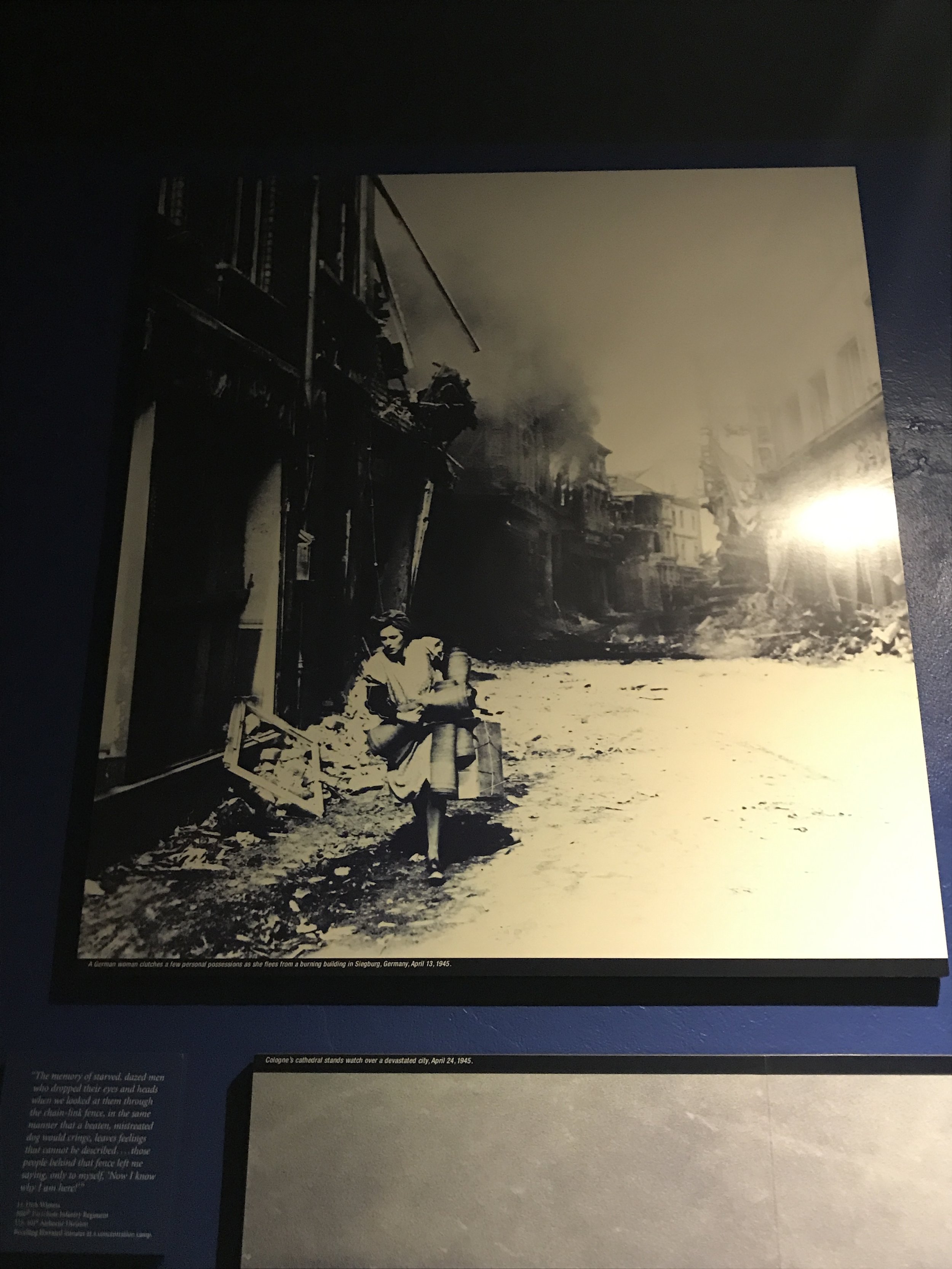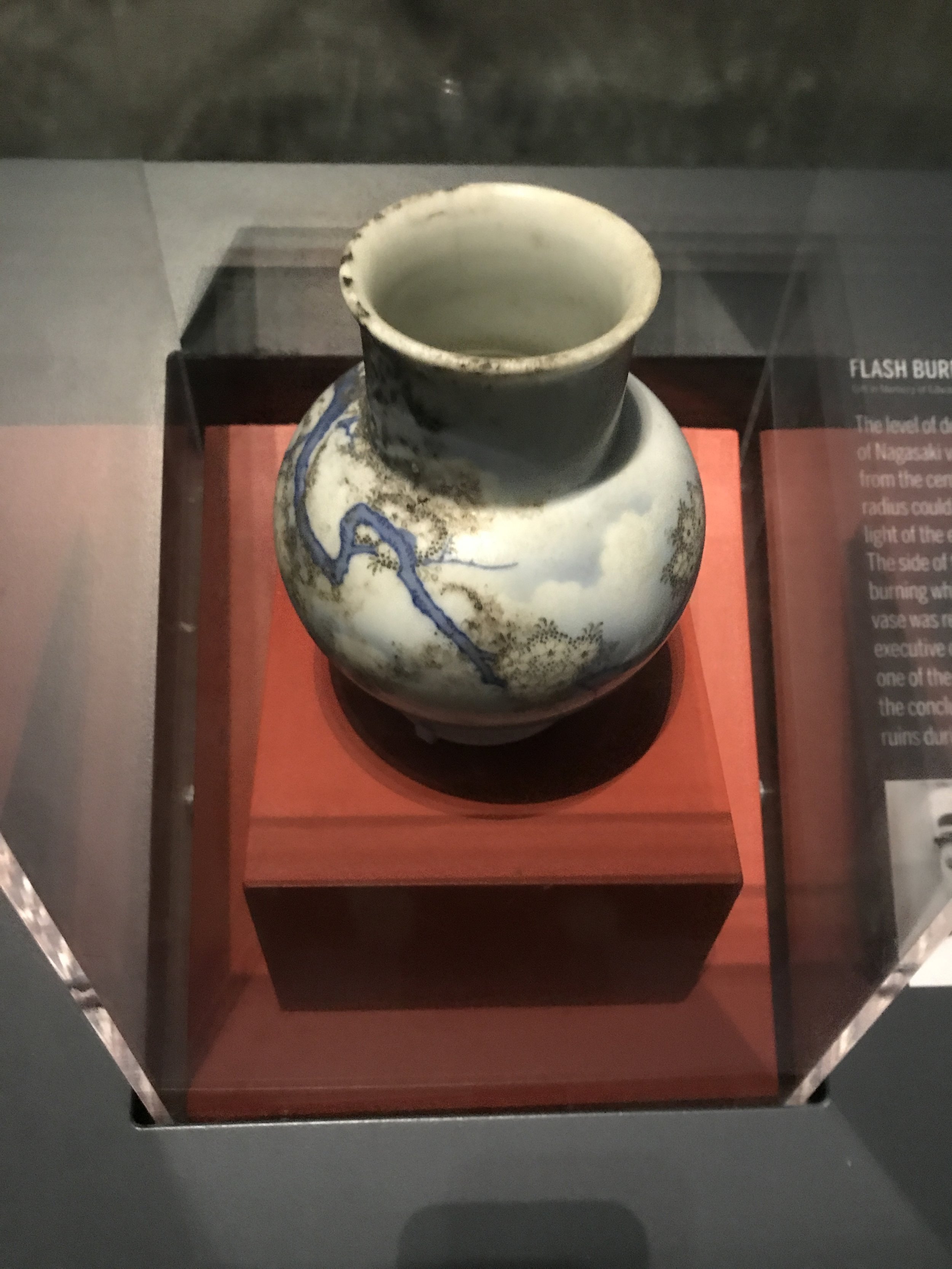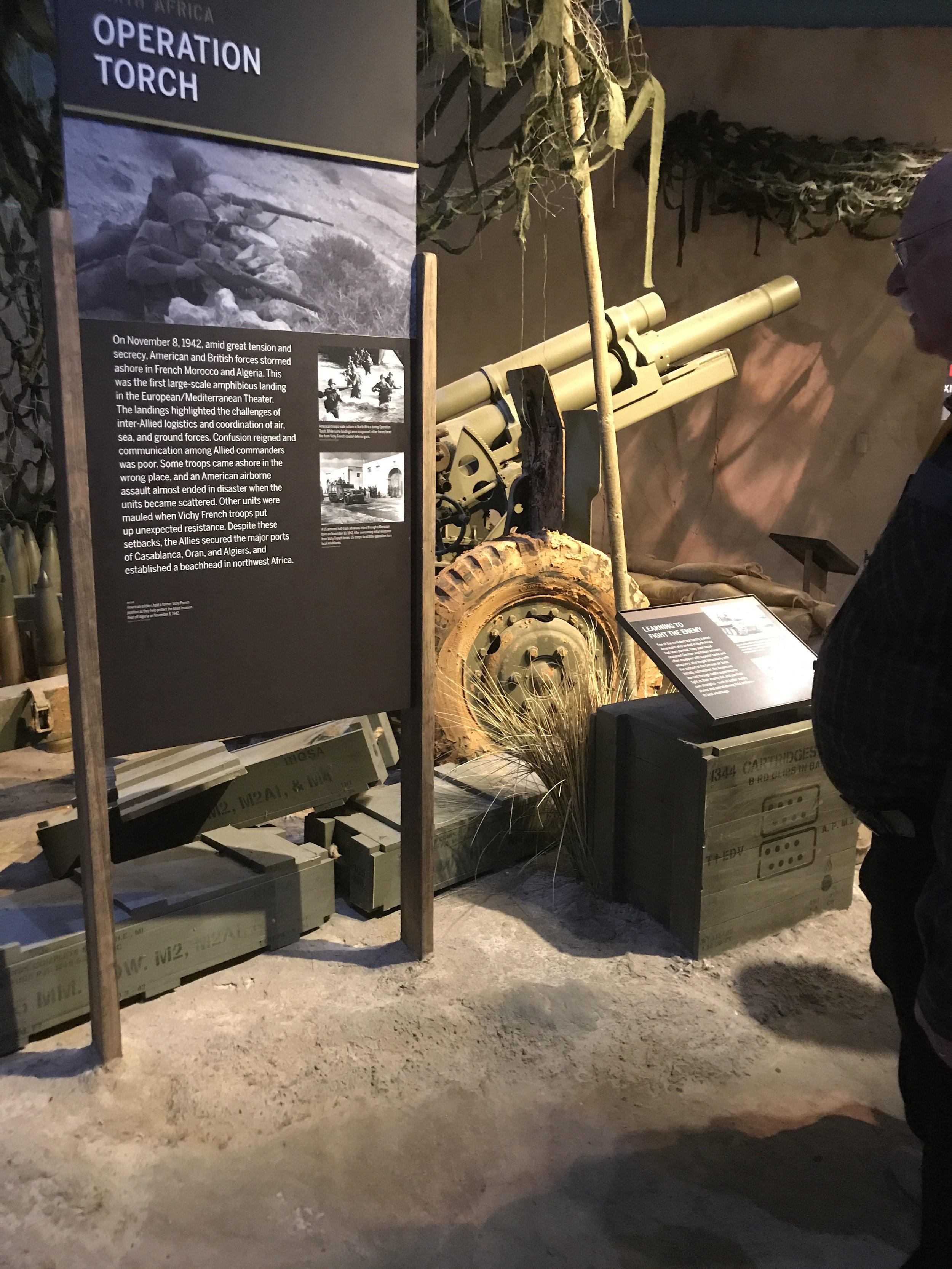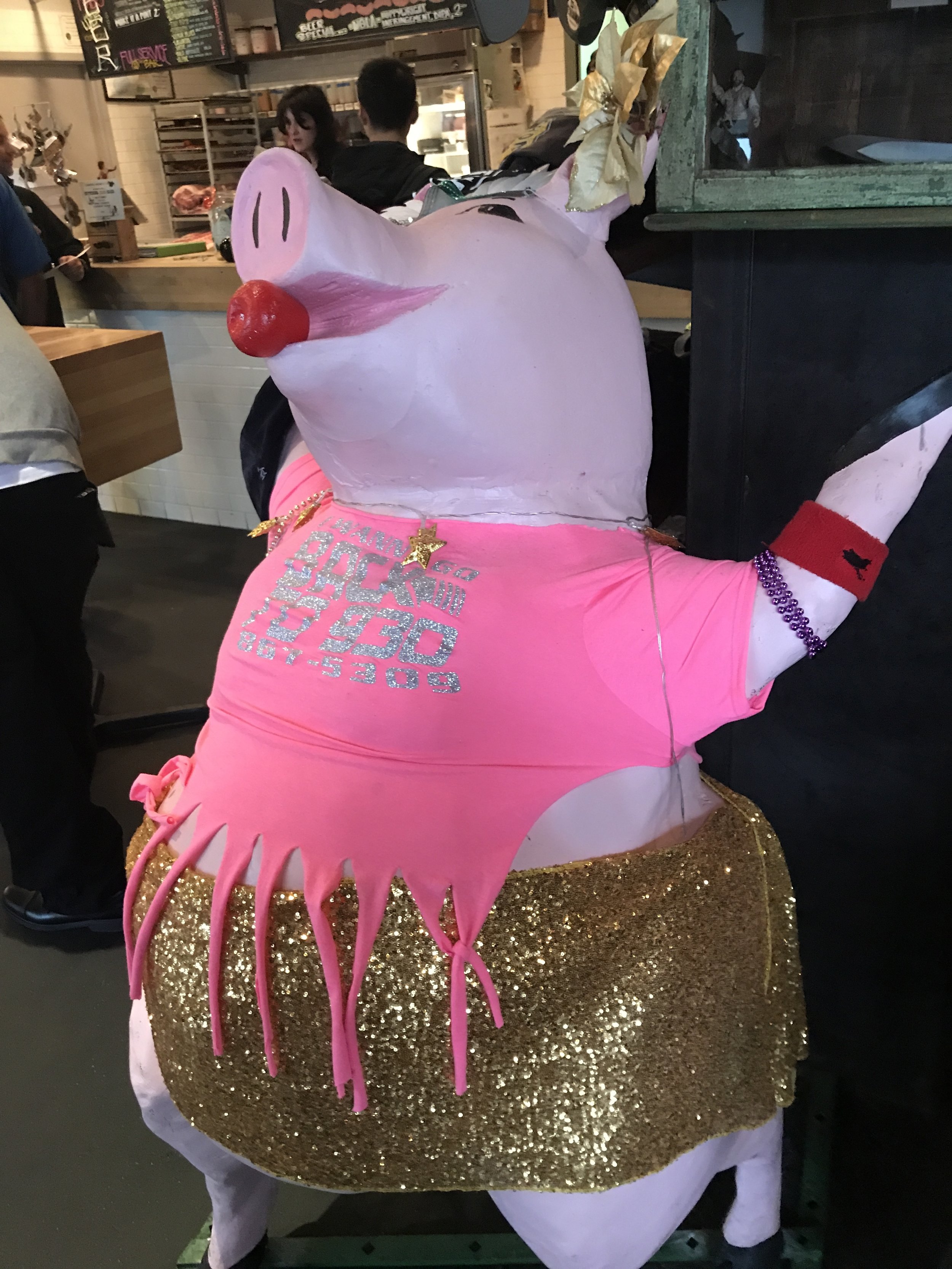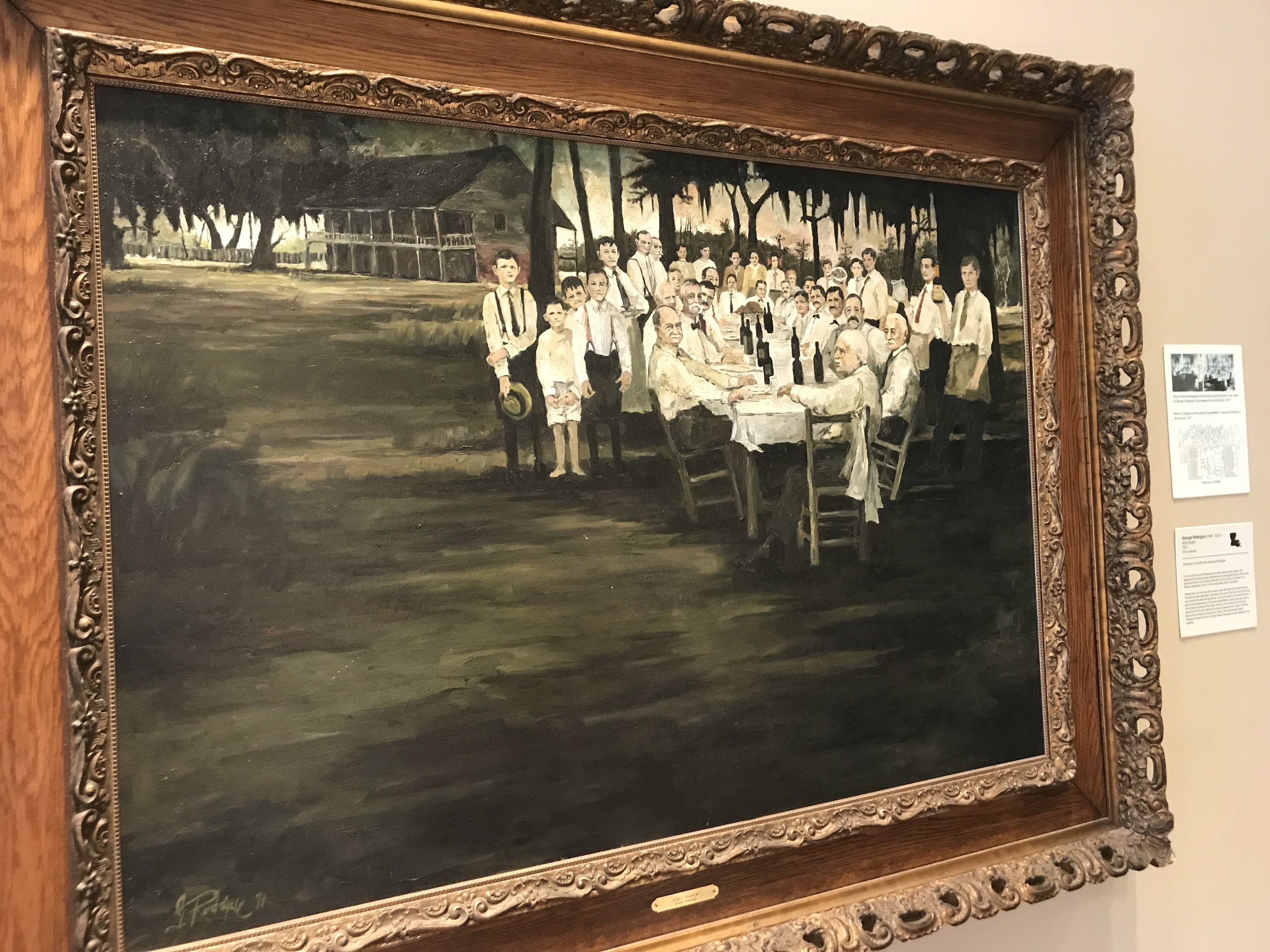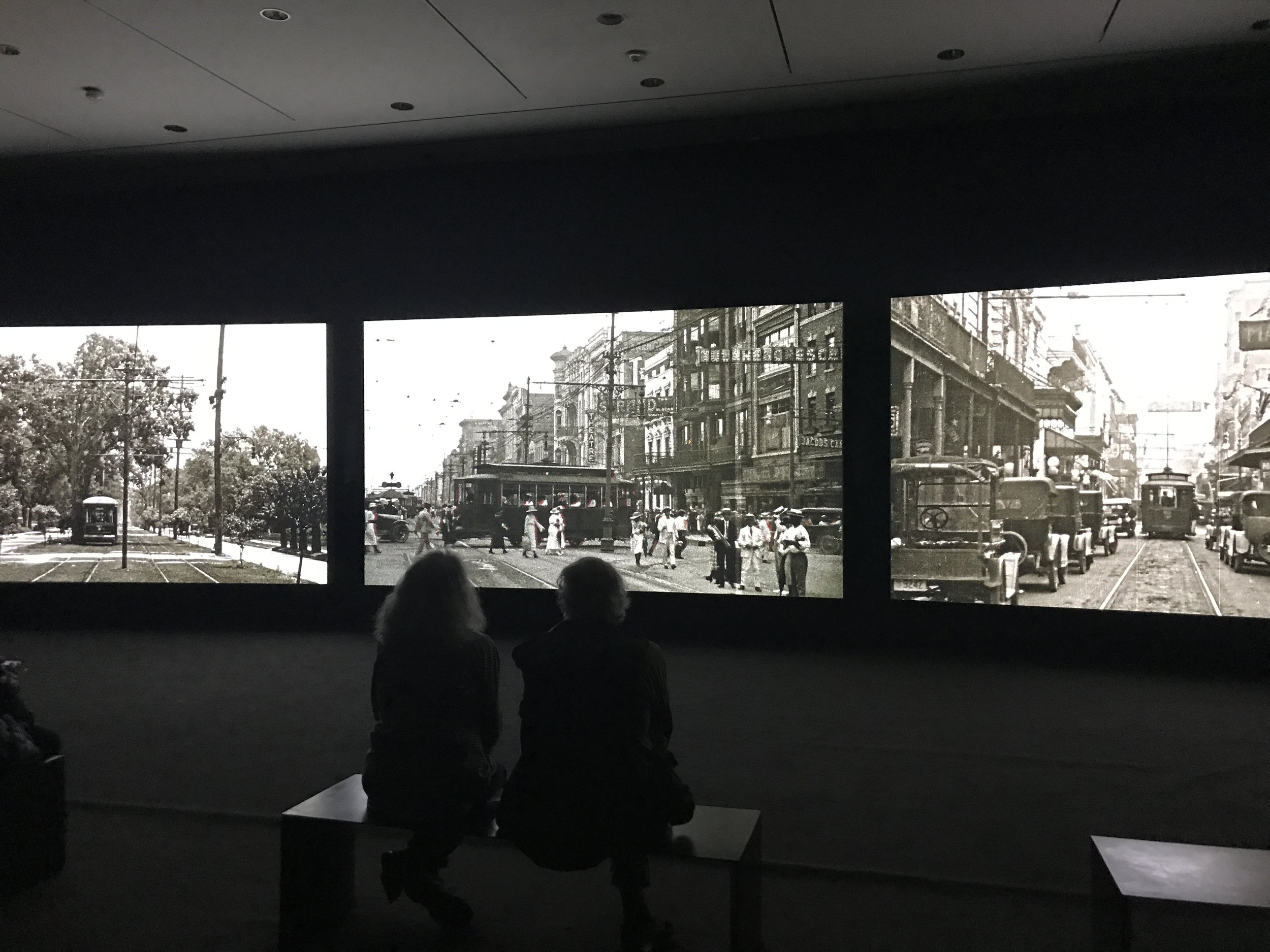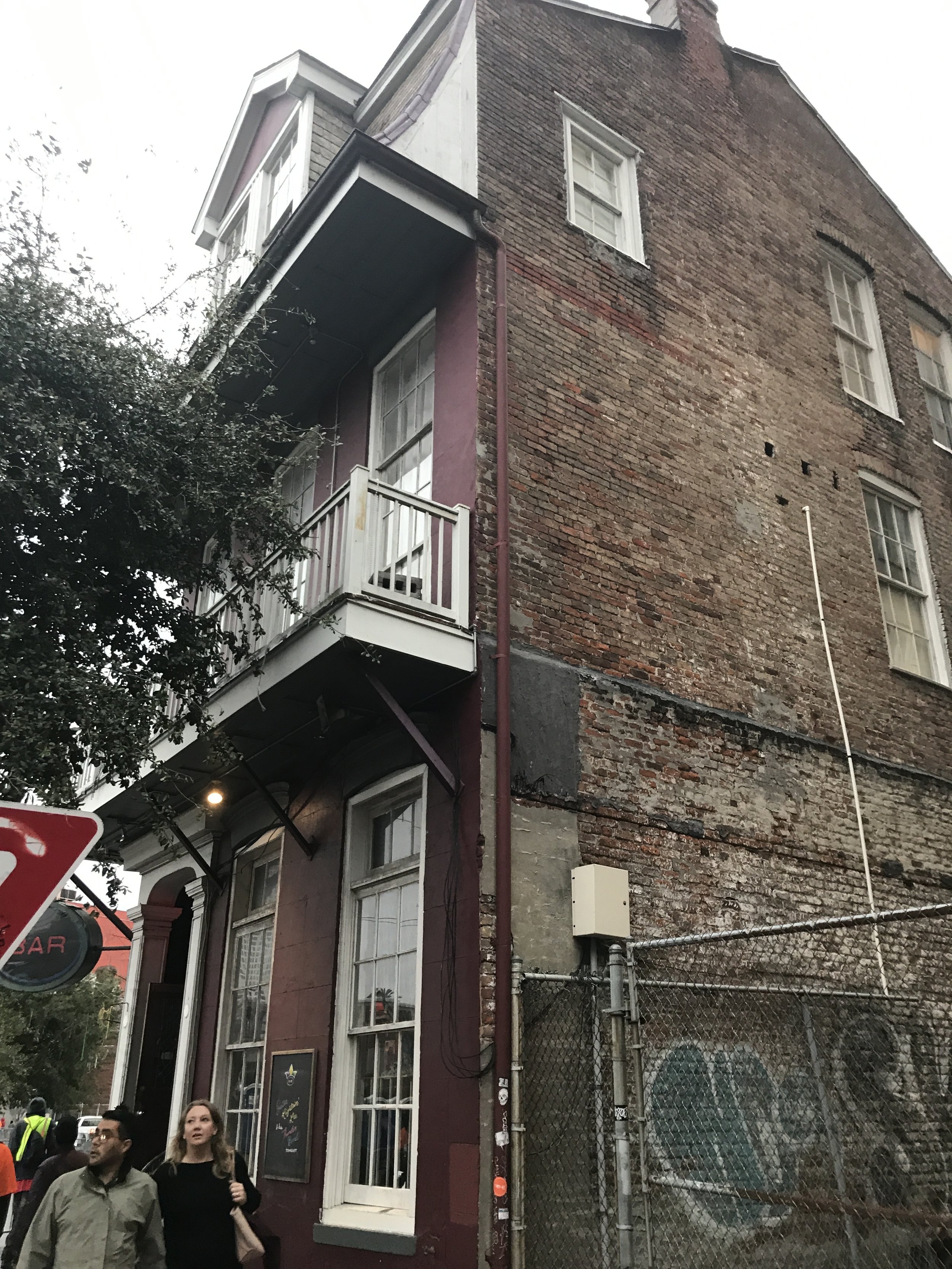NoLa Day 3- Pigs, Puppets, and Panzers
Today we started by going to the Warehouse District/ Downtown neighborhood. We got coffee at a place called Mammoth Espresso. I sort of expected from the name that the coffee would come in giant sized portions, but instead it was just really good normal sized coffee, which is really nothing to scoff at.
Not long after we got our coffees and began heading for our first stop, my mom called to talk to me about my taxes. This doesn't seem super exciting, but it turned out that she had accidentally made my online account with a typo in the email, but the state would need my permission to change it so I had to call them. About 15 minutes of being on hold later, I had to give the woman Massachusetts Department of Revenue my username for the site, which as it turns out my mom, thinking I would never see it, made Miriam's Baby. I can't really complain knowing that I'm very lucky my mom is still doing my taxes for me, but that was such an insane thing to have say with a straight face.
Our first non-coffee stop was the WWII museum, which basically everyone had recommended as a must see in New Orleans. I was intrigued, because I'd been to history museums before so I wasn't sure what would make this one so cool that people kept raving about it.
Things started off looking pretty cool before we even set foot in the museum with an actual fragment of the Atlantic Wall hanging out across from the entrance. The walls had been put up in Germany to stop allied forces. Clearly it didn't quite succeed on that front.
When we walked into the main lobby we were immediately greeted with full sized airplanes hanging from the ceiling. It was a stunning introduction and really gave the first indication of two of the things that do make this museum stand out so much: 1- it's freaking massive. We were there for four hours and still didn't see everything and 2- the artifacts they have and the way they're curated is amazing. The lobby also had other military vehicles including a tank and a mobile loft for carrier pigeons.
The little hall of vehicles led to a full sized train car where visitors are shown an introductory film projected along the train windows that welcomes you to the museum and does a little scene setting of what the world was like in the time leading up WWII. You are also given your souvenir digital dog tag. This assigns you a person involved in the war whose story you can check in on at various stations. I got a submarine commander Dudley "Mush" Morton who commanded a sub called the Wahoo which sunk in the pacific but not before sinking 19 Japanese submarines, the highest number of any single US vessel. My sister got Bob Hope as her dog tag person. This was a cool little way of maintaining a real human element even through all the larger historical contexts.
In case you, like me, were wondering what New Orleans' connection to the war was that led to the museum being here, the first exhibit helped answer that question as it was all about New Orleans during the war. The biggest connection was that New Orleans was the home of Higgins Industries where Landing Craft, Vehicle, Personnel (LCVP) boats were manufactured. Between WWI and the Depression, the US' military infrastructure had been seriously depleted, so the ability to produce these multi-function boats in high numbers actually played a huge role in turning the tide of the war. The other items from the New Orleans gallery painted interesting portraits of different ways Louisianans contributed to the war effort at home and abroad, including uniforms, photographs, and personal items. The tales of soldiers' bravery were really cool, but for whatever reason I was more struck by a lot of the domestic things because I'd never really appreciated all encompassing the war effort became to the point where Louisiana had to make special wooden license plates because they needed to melt down older ones for usable metal.
The most interesting artifacts for me were this wreath and this photo. The wreath was made by German and Italian POWs who were shipped to Louisiana to replace the lost farm labor. I had just never really known before that we had captured POWs on our own soil. For whatever reason I just assumed they were all kept in Europe and Asia. The photo I liked more just because it was a heartwarming story about Billy Michal, a little five year old boy who helped his town win a statewide "scrapping" competition to contribute the most scrap metal to the war. He even sacrificed his own toy wagon to the cause, and for all his hard work he was selected to get to travel to New Orleans and watch a battleship get launched. It was really sweet.
The next exhibit was on pre-war conditions in Germany, Hitler's rise to power, and America's reactions. The thing that really struck me about this exhibit is how eerily similar exact phrases are to current buzzwords in politics. Hitler talked about "making Germany great again" and an "America First" party actually sprung up in the states to try to elect officials that would keep us out of any European involvement. I'm not trying to compare any current politicians to Hitler, but the fact that similar feelings of nationalism and discontent were swirling around then as they are now makes me a little nervous. The other striking thing was how terrifying methodical Hitler was before he ever made any actual military moves. Before the war even started, he had gradually raised Germany's standing army to be the largest in the world, nearly ten times that of the US's. It's really scary how calculating every move of his was toward eventually trying to conquer the world and commit genocide. He really is such an evil character that it would be cartoonish if he hadn't killed so many people. On that note, I did notice looking at Nazi flags that they really look like the kind of flags bad guys would have. at It could just be such a strong association through movies and thing, but with the Hard corners and dark colors, it's a genuinely spooky flag. I also liked one headline regarding the invasion of Czechoslovakia that just said "Hitler Breaks His Promise". Breaking promises? That's really where he crossed a line.
The image from this exhibit that stuck with me the most though was this picture of children in Weimar Republic-era Germany using stacks of money as building blocks because their currency had such low value and inflation was out of control. It gives you an idea of just how bad things got that the country was actually vulnerable to someone like Hitler.
After that there was an exhibit on the homefront during the war. This included a scale sized model 1940s home. The artifacts were mostly there to paint a portrait what life would actually have been like in the average (white, middle class) home at that time. There was a lot of advertisements aimed at women and children about rationing and how they could help out. My favorite slogan was "Send a Salami to your boy in the Army" because I love a good forced rhyme. They also talked about FDR's fireside chats, which while quaint now, were actually a pretty ingenious use of technology at the time to make people feel like their President cared about them on a more personal level and also to provide up to date information.
I really liked the next exhibit which so how vastly dichotomous the US was at this point of time in terms of race and gender relations. On the one hand, it was a time of unprecedented opportunities for advancement for women and minorities in the workforce and military, but socially at home there were some extreme heights of discrimination, race riots, and of course worst of all the the Japanese internment. The fact that German and Italian-Americans were not subjected to the same treatment as the Japanese-Americans suggests to me pretty definitively that the internment was more inspired by racism than national security. That being said, I do think the liberties gained during the war probably kick started the civil rights movement into high gear in the following years.
The next exhibit was all about manufacturing and technological advancements made on the home front, including the Manhattan Project and the birth of the atomic bomb in the sand dunes of New Mexico.
My favorite thing here was an actual rivet machine used by female factory workers. You could even move the little rivet gun to get a feel of what hard work it was. Unfortunately I didn't have a bandana, so I couldn't do a believable Rosie the Riveter impression.
The next exhibit was all about D-Day. This started with an overview of all the German defenses on the beach and what an uphill battle the invasion would be. The Germans thought they had created an system that would be totally impenetrable. There was even full scale replica of the German Watchtower which gave you a feeling for how decked out they were in case of an attack. One of the defenses's was a wooden post with a mine attached to the end which was called Rommel's Asparagus which is way to cutesy a name for something like that.
After the defenses were cases full of all the different weapons used by the German and American soldiers. It was really cool seeing how much they different in terms of their aesthetics. Early in the war, the Germans had a distinct advantage, but American weapons manufacturing eventually caught up.
Past the weapon shelves was an overview of all the Allied planning that went into the invasion. It was incredible how precise everything had to be. They really only had one chance, and it wouldn't be easy. My favorite thing to learn about though was all the misinformation the Allies intentionally spread to make Hitler think they were going to be landing at a different beach. Apparently coming up with these elaborate lies was actually Winston Churchill's favorite part of the war. Moreover this was subterfuge was incredibly effective as Hitler waited a very long time to send in reinforcements to Normandy because he was convinced that it was just a small force being used as a distraction from the real invasion. The time bought from this deception was absolutely invaluable.
My favorite piece of trickery was called Rupert and he was a fake soldier attached to a parachute, named Rupert. Ruperts were dropped out of planes along with real soldiers away from the main D-Day site to distract German soldiers and make them think there was a much bigger aerial assault taking place. The Ruperts were also accompanied with speakers playing fake gunshots to make the drop even more convincing and disorienting. I love that something so silly actually really worked against highly trained German soldiers.
After learning about all the plans that went into the invasion it was time for the event itself. As much as movies like Saving Private Ryan try to dramatize how intense the storming of Normandy was it's pretty hard to compete with the actual photographs. It was gruesome, but ultimately it marked the beginning of the end for the war in Europe. The exhibit featured a mix of photographs, models, and quotes from soldiers who were there. The quote that really struck me was someone saying "We were so young and so stupid and we had no idea what war was like" Rest assured, it wasn't exactly what they were expecting from John Wayne movies.
After the D-Day exhibit, you actually walked over a sky bridge into another building (did I mention this museum was huge?). The next building had a movie theater, a cafe, and an exhibit on the Merchant Marines. We didn't feel like paying the extra money for the movie or any food, but the Merchant Marines exhibit was fascinating because you almost never hear about them in WWII narratives. They truly were the unsung heroes of the war providing much needed supplied to the Allied forces all over the world and sustaining more casualties than any other branch of the military, all while receiving no military benefits from the government because of their status of technically being civilians. It was pretty stunning to think of the bravery it takes to sail past mines, torpedoes, and bomber planes with so much less weaponry for so much less reward. Their unusual status of being not-quite full military and not quite full civilians also had the cool by-product of the mariners having one of the the first Black captains leading the first integrated crew into the war.
From there, you walked over another sky bridge into another building (again, huge) where there was an exhibit all about the Pacific theater of the war. This exhibit started with you walking into a giant replica of a submarine command station so that was a pretty great way of starting things off. I feel like because Hitler is the clear comic book villain of the war, we tend to think of the European battles, but it's weird to think that we got into the war because of Pearl Harbor so we only even fought Hitler because he was allies with Japan. In a lot of ways, the war in the Pacific feels like a totally separate war that was happening at the same time. The tactics were different, the machinery was different, the landscape was different, and it was really something none of our prior military experience had prepared us for. The stories of naval and aerial battles sound so harrowing because soldiers didn't only have to worry about enemy fire but fuel and not being stranded in the middle of the ocean. As terrifying as all warfare must be, I'd much rather do it on solid land. Perhaps that's just me but I think there's comfort in that. The number of times that if they had just landed one more bomb on a supply ship that the whole war may have turned times is alarming. One of the other alarming things was how much our torpedoes totally sucked and frequently misfired, because we had to really rush production to even have enough warships.
This exhibit had a cool mix of immersive environmental recreations, artifacts, videos, photos, and first hand accounts. The thing I was most suprised to learn was how much Mao Zedong and the Chinese military helped the allied forces. He's so frequently portrayed as an enemy of the states after the rise of Communism, but we might not have been able to win the war without him. Other things I found interesting here were all the elaborate booby traps that Japanese forces established on different islands to provide defenses once the Allies started making more headway. I also liked that they had some political cartoons from Japan at the time portraying FDR as a Frankenstein-like monster. I feel like we know about a lot of really racist anti-Japanese propaganda cartoons that happened here, so it's kinda interesting to see that to some extent they had the same thing going on over there.
Probably the most interesting items were artifacts that had survived the atomic bombs at Hiroshima and Nagasaki and had interesting color bands or deformations. The destructive power of those bombs chills me to the bone. They're just so scary. I think we probably saved a lot of American lives with them, but I still don't think we should've have dropped them if only because we had no idea what was actually going to happen. The destruction they caused was enormous, bur for all we knew when we dropped them it could have been so, so much worse. That was a really dangerous gamble to make. I do think the whole issue could have been avoided if Emperor Hirohito had just surrendered, and I think it's unconscionable that he didn't. There's good reasons to fight an uphill battle, I'm sure, but sacrificing the lives of your own countrymen just to save face is beyond shitty (which isn't to say we haven't done it ourselves in Vietnam and to some extent now, but it's bad reason no matter who does it). There's a really manga series I had to read for a class called Barefoot Gen, which is written by an actual Hiroshima survivor. The accounts of the bombing itself are horrific but the part I liked most was the stories about Gen's dad before the war trying in small ways to rebel against the dictatorship. I like these stories because they really show that people are people wherever and whenever you look, and while I think a lot of narratives focus on the Japanese following the emperor whole-heartedly, obviously that wasn't universally true. One of the scene in the book also has probably the most tense fart joke in literature as the dad shows up to military training drunk as an act of defiance but keeps farting, which is really funny until you realize there is a real threat of him being killed for that. It's so interesting how absurd situations are pivotal in both comedy and horror and scenes can really change on a dime.
The lower floor of this building had exhibits on the rest of war efforts in Africa and Europe. The exhibits about the African front were really interesting to me, because that also doesn't get quite as much popular narrative focus. Seeing photos of planes flying by pyramids was a sort of surreal mix of historical imagery. This exhibit also covered the war in Italy and Germany post-D-Day. The recreations of Eastern European forests were pretty amazing, but I'm glad I didn't have to be there in the winter with people shooting at me.
The thing from this exhibit I was most excited to see was a little shout out to Kurt Vonnegut for his time as a POW in Germany where he witnessed the firebombings of Dresden, inspiring his most famous book Slaughterhouse Five and his less famous but maybe even better book Mother Night. Vonnegut was a big bonding point for me and and my sister so it was cool to see him there with her.
From there, we were done with this building but not with the museum and we walked around the corner to another building with a special exhibit about science and technology that came out of the war. The items in this exhibit were mostly things that were too big anywhere else and they included tanks, boat engines, and my favorite, a giant metal ear created to try to detect sounds from greater distances.
At this point, we were pretty darn hungry from our four hour jaunt through history so we decided to get some food at a place called Cochon Butcher, which is a butcher shop (shocker) and deli affiliated with the nearby fancy restaurant Cochon. Cochon is frequently considered one of the best restaurants in the city, but my friend from NoLa said that the Butcher shop was much cheaper and honestly maybe better. I can't attest to whether or not it's better but it absolutely was amazing. I got a pork belly sandwich after agonizing over that decision for a while, and it was one of the best sandwiches I've ever had. The pork was so flavorful and juicy, and the bread was perfectly toasty. There was cucumber and mint on top, which I wouldn't have thought of as a good combination but it really worked. Now you might be wondering, Joe, you insensitive dingus, did you bring your vegetarian sister to a butcher shop and just taunt her with their amazing pork? Yes and no, because she was able to get a big ol' bowl of their mac and cheese, and while I wouldn't trade in my pork I'd be tempted. She'd never had southern mac and cheese before, and I think like me she was converted at the first bite. I don't even know why it's so much better, it just is. In keeping with the Vonnegut from earlier, my sister also ordered a cocktail because it was named after one of her favorite characters from one of his books, Eliot Rosewater. The drink had egg whites in it though, which kind of grosses both of us out even though it's not super uncommon so I think the name was a little better than the drink.
To make the place even better in my book, they were decked out with some great weird art including a diorama of the restaurant populated by different superheroes and Star Wars action figures and a giant inflatable pig wearing sequin booty shorts. You know the things, you always feel like most restaurants are missing.
For dessert, I couldn't resist getting a bacon praline. It was great brown sugar and pecan base with big chunks of their bacon in it. Maybe bacon and candy sounds a little gross, but I loved every disgusting bite.
After lunch, we went to the Ogden Museum of Southern Art which was just a few blocks away. The museum mostly focused on modern and contemporary works by Southern Artists. The first wing showcased works by local Louisianan artists including some funky abstract sculptures, a painting of a slightly ominous family reunion, and a very striking embroidered portrait of a figure skater.
This museum was also participating in the Prospect 4 city-wide art project and once again the P.4 artists were real highlights. Things started with paintings by an artist named Wayne Gonzales. From a distance his works look totally photo-realistic but they're actually made from tiny repetitive geometric shapes so up close it actually looks sort of abstract and pixelated. I don't understand at all how he's able to create so much depth and nuance that way, when I couldn't do that even if I was just trying to do the image with a more straightforward method. It was very impressive.
The next P.4 artist was Andrea Chung who wall papered an entire room in differently layered cyanotype prints on watercolor paper. This created an effect of total immersion and the gentle blue and white of the paper was oddly soothing. Along the walls, were images of reefs and sea life with the lionfish being the primary focus of the piece. The lionfish is an invasive species so it's presence adds a little hint of darkness under the gentle surface of piece which is likely a big factor to it being named Spectre.
The previous room was my sister's favorite, but the next P.4 artist was my personal favorite. Patricia Kaersenhout created a series of mixed media works which took notable white men throughout American history and collaged in drawings of insects and photographs of African-American and Native Americans. The works were intended to demystify these "heroes" by acknowledging and condemning the abuse of minorities that so frequently led to their power. I really liked these pieces because they were so creepy looking but they had a righteous sort of anger to them.
Next up was a series of very impressive woodcuts by an artist named John T. Scott. These pieces were impressive because not only were they extremely large but they were also incredibly cluttered trying to capture all the hustle and bustle of urban settings into the two dimensional space of a wooden plate. They were pretty amazing and there's so much imagery crammed into them that they almost look abstract until you realize whole city scenes are unfolding.
After that it was back to the museum's permanent collection for a series of works from Louisiana and beyond that tried to capture Southern landscapes, architecture, and culture to admirable effect.
My favorite pieces from here were a series of sculptural sandwiches by an artist named Rontherin Ratliff and a painting by John McCrady called the Parade which captured the excitement inside and outside as people prepare for a Mardi Gras parade by drinking, dancing, fighting, and painting each other naked. That last one might be have been more common among painters like McCrady but who knows it could just be an odd evolution of board game night.
The next gallery was all about self-taught artists which I always really like. I do have to wonder though why so many folk art focuses so heavily on nightmarish imagery. Is it because all imagery becomes slightly nightmarish when certain artistic training is missing or is something else going on their because at least 75% of these works have weird dark shit going on in them.
The last floor of the museum had probably the most exciting exhibit to me because it was all about avant garde puppetry. The art was the product of husband and wife team Quintron and Miss Pussycat. Miss Pussycat made the actual puppets, and Quintron supplied ideas and music for the videos they'd eventually make with their puppets. I can't resist weird puppets wherever I go, so I loved this exhibit. There was just so much imagination on display in the character designs. The gallery brought together actual puppets, ceramic models of puppets, an inflatable stage, videos, and excerpts from storyboards used for the videos. The videos we watched were super weird and vaguely unsettling, but they did seem to have complicated mythology of inter-connected puppet story arcs. I could probably have spent the rest of the day their trying to piece it all together.
The other big exhibit on the top floor was a film installation by John Akomfrah about the life and times of Buddy Bolden one of the first real pioneers of jazz trumpet who unfortunately struggled with some pretty serious mental health issues. The story seemed fascinating and the film was beautifully shot, but we came in in the middle and didn't actually stick around to watch a whole lot of it because we were a little lost.
Lastly, we saw a cool special synthesizer created by Quintron that was connected to all kinds of weather machines on the roof outside and created randomly generated music based on fluctuations in weather. It was super cool organically inorganic music. I don't think I'd listen to any of it on the regular, but I like that someone did it.
While we were walking out of the museum, I slipped on some wet concrete and fell in a mud puddle, which my sister alludes to in her comment on yesterday's post. I then became a bit of a "grump" in her words, but I was still sore from my car accident and I had only packed two pairs of pants so I think some light grumping may have been justified. It did not help all she did was point and laugh. In hindsight, I can agree that it was probably super funny and I shouldn't take myself all that seriously but in the moment I was less than amused and pretty pissy which I'm sure wasn't fun for her to deal with.
We went to a nearby bar my friend recommended called the Circle Bar, because they'd have a sink I could attempt to wash the mud off in and because beer does help soothe even the pissiest of moods. Or it makes things way worse, but in this case it had more of an ameliorating effect. Plus the bar was in a super cool old building so it was hard not to like it in there.
After cooling down a bit, we realized that we had been in New Orleans for nearly three days and not gotten Po' Boys which may or may not actually constitute a crime. We went to a place called Mahoney's which is known for having some good old fashioned Po' Boys. I went full cajun and got alligator sausage. The sausage was actually a blend of gator and pork, and it tasted so good. The twelve inch baguette it was served on didn't hurt either. And unlike in the more touristy neighborhoods, the sandwiches were actually priced to fit a po' budget.
After dinner, we got a lift Uptown to where the mic for that night would be. We had some time to kill o we hung out in a coffee shop called Rue de la Course. My friend said that's her favorite cafe in the city, and I think she might be right. The building is absolutely beautiful with big open spaces and old-fashioned chandeliers, and the coffee was out of this world tasty. I don't say this often, but their flavored coffee might actually have rivaled if not exceeded my hometown favorite, Mary Lou's. It was a good place to sip and write, while my sister sipped and read.
After that, it was time for the open mic. It was at a bar called Carrolton Station. Normally I think it's one of the bigger mics in the city, but a combination of bad weather and mardi gras parades led to a fairly small turn out.
The people who turned out though were really great. In particular, this was a strong turnout for the city's female comics as I think easily all the best sets that nights were from women. Unfortunately, I was in the bathroom at the start of my favorite comic of the night's set so I didn't catch her name but her joke that really killed me was: "I don't trust any girl in porn who starts moaning while she's giving a handjob. What's in that for her? How am I supposed to believe anything else after that?"
Other Highlights:
Kate Mason, on a creepy dude dancing on her at a concert: "Oh wow I didn't even wear this outfit thinking I might meet my future husband tonight"
Abbie Isaacoff- Tourists are like the blood of the city. It's really gross seeing them in the streets.
My own set went pretty decently, but a good chunk of the small crowd had already heard most of the jokes I did so they understandably had diminishing results. One guy in the front row, I'd never seen before really liked my set but he was a bit of an outlier. Still, I'll take it.
Favorite Random Sightings: Rodent Guard; Look Better Naked Tattoos; Our Business Stinks, but It's Picking Up (garbage truck slogan); Ugly Dog (hot dogs); Trashy Diva; Zestosterone
Regional Observations: A girl my age at the bar told me that at her public school in Louisiana they'd send home slips that parents could sign that gave teachers permission to use corporal punishment. That's within the past 20 years which is just nuts to me
People's Favorite Jokes:
Why didn't the mayonnaise want the fridge opened? It was dressing.
Song of the Day:





